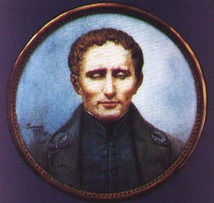Braille: Facilitating the Lives of the Blind
The Invention of Braille

Louis Braille was born on January 4, 1809 in Coupvray, France [1]. At the age of 3, he injured his eyes while unsupervised his father's workshop. The injury became infected and he became blind [1]. At this time, if blind people's families were not wealthy, they usually ended up as beggars [5]. Luckily, Braille was able to attend The Royal Institute for Blind Youth in 1819 [1]. He was a very good student and did well in all his classes [5].
At the time, the institute taught them mostly verbally, because there was no good system for reading yet [1]. The school had very few books, and they were written in raised letter. This was simply embossed writing, so blind readers had to trace each letter with their fingers to figure out what it was [1]. This system was extremely tedious and slow to read. Also, if a child was born blind, they wouldn't even know what different letters looked like, let alone felt like. This made the system even harder to learn and use.
Around this time, Charles Barbier (an army captain) developed a system called "night writing" [2]. This was a system of raised dots and dashes that allowed soldiers to send the messages that could be read in the dark [2]. It was a very crude system because instead of each symbol representing a letter of the alphabet, each symbol represented a certain phonetic sound [3]. Later on, Barbier adapted night into Sonography, which was specifically designed for blind people [3].
Though the system had many flaws, Louis Braille recognized the usefulness behind the it and began to work on revising it. He finally completed his new alphabet when he was 15 years old, in 1824 [5]. He continued to adapt the system and produced a way to write a music in braille [5]. In 1829, he published his work in a booklet explaining braille [4]. Although many of his fellow students and other blind people quickly began to use the system and realized how useful it was, it took them till 1844 for braille to be officially recognized [4]. Later on in his life, Braille became a teacher at the institute and provided education for blind children [5]. Braille died at the age of 43 on January 6, 1852 [1].
At the time, the institute taught them mostly verbally, because there was no good system for reading yet [1]. The school had very few books, and they were written in raised letter. This was simply embossed writing, so blind readers had to trace each letter with their fingers to figure out what it was [1]. This system was extremely tedious and slow to read. Also, if a child was born blind, they wouldn't even know what different letters looked like, let alone felt like. This made the system even harder to learn and use.
Around this time, Charles Barbier (an army captain) developed a system called "night writing" [2]. This was a system of raised dots and dashes that allowed soldiers to send the messages that could be read in the dark [2]. It was a very crude system because instead of each symbol representing a letter of the alphabet, each symbol represented a certain phonetic sound [3]. Later on, Barbier adapted night into Sonography, which was specifically designed for blind people [3].
Though the system had many flaws, Louis Braille recognized the usefulness behind the it and began to work on revising it. He finally completed his new alphabet when he was 15 years old, in 1824 [5]. He continued to adapt the system and produced a way to write a music in braille [5]. In 1829, he published his work in a booklet explaining braille [4]. Although many of his fellow students and other blind people quickly began to use the system and realized how useful it was, it took them till 1844 for braille to be officially recognized [4]. Later on in his life, Braille became a teacher at the institute and provided education for blind children [5]. Braille died at the age of 43 on January 6, 1852 [1].
Picture: "Louis Braille" <http://mediatheek.thinkquest.nl/~lle0498/braille/braille.html> (Dec 10, 2009)
1. Carolyn Meyer "A New Method: The Story of Louis Braille" <http://louisbrailleschool.org/resources/louis- braille/> (Dec 8, 2009)
2.“The Story of Braille” <http://www.valleybraille.com/braille.html> (Jan 6, 2010)
3. Barry Hampshire, Working With Braille. (Lausanne: Unesco, 1981)
4. “Invention of Braille” http://www.rnzfb.org.nz/ourservices/readingandwriting/braille/introductionbraille#invention-of-braille(October 14, 2009)
5. Jean Roblin, The Reading Fingers. (New York: American Foundation for the Blind, 1955)
1. Carolyn Meyer "A New Method: The Story of Louis Braille" <http://louisbrailleschool.org/resources/louis- braille/> (Dec 8, 2009)
2.“The Story of Braille” <http://www.valleybraille.com/braille.html> (Jan 6, 2010)
3. Barry Hampshire, Working With Braille. (Lausanne: Unesco, 1981)
4. “Invention of Braille” http://www.rnzfb.org.nz/ourservices/readingandwriting/braille/introductionbraille#invention-of-braille(October 14, 2009)
5. Jean Roblin, The Reading Fingers. (New York: American Foundation for the Blind, 1955)
